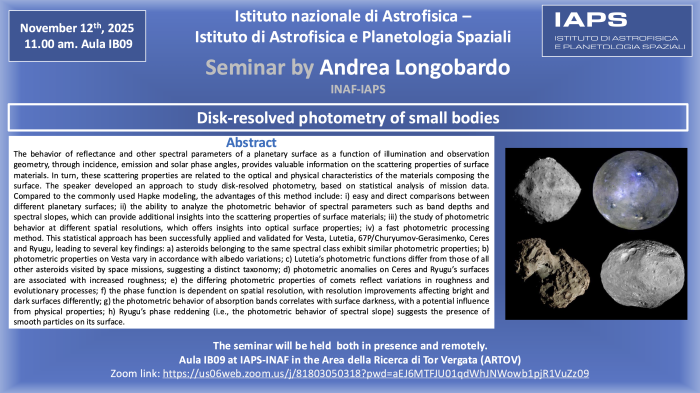Disk-resolved photometry of small bodies
Affiliation: INAF-IAPS

The behavior of reflectance and other spectral parameters of a planetary surface as a function of illumination and observation geometry, through incidence, emission and solar phase angles, provides valuable information on the scattering properties of surface materials. In turn, these scattering properties are related to the optical and physical characteristics of the materials composing the surface. The speaker developed an approach to study disk-resolved photometry, based on statistical analysis of mission data. Compared to the commonly used Hapke modeling, the advantages of this method include: i) easy and direct comparisons between different planetary surfaces; ii) the ability to analyze the photometric behavior of spectral parameters such as band depths and spectral slopes, which can provide additional insights into the scattering properties of surface materials; iii) the study of photometric behavior at different spatial resolutions, which offers insights into optical surface properties; iv) a fast photometric processing method. This statistical approach has been successfully applied and validated for Vesta, Lutetia, 67P/Churyumov-Gerasimenko, Ceres and Ryugu, leading to several key findings: a) asteroids belonging to the same spectral class exhibit similar photometric properties; b) photometric properties on Vesta vary in accordance with albedo variations; c) Lutetia’s photometric functions differ from those of all other asteroids visited by space missions, suggesting a distinct taxonomy; d) photometric anomalies on Ceres and Ryugu’s surfaces are associated with increased roughness; e) the differing photometric properties of comets reflect variations in roughness and evolutionary processes; f) the phase function is dependent on spatial resolution, with resolution improvements affecting bright and dark surfaces differently; g) the photometric behavior of absorption bands correlates with surface darkness, with a potential influence from physical properties; h) Ryugu’s phase reddening (i.e., the photometric behavior of spectral slope) suggests the presence of smooth particles on its surface.


